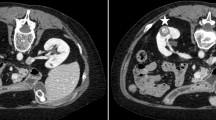Abstract
Purpose
Nephron-sparing surgery (NSS) is the gold standard treatment for resectable renal tumors. In the last decade, laparoscopic partial nephrectomy (LPN) has evolved in technical, surgical and oncological aspects and is an accepted treatment option for local-stage renal tumors. Improvements in not only surgical techniques, but also potent hemostats have encouraged this evolution. Here, we report our initial experiences with a new hemostatic agent, Hemopatch® (polyethylene glycol-coated collagen patch, Baxter), in zero-ischemia LPN.
Methods
Seven patients with confirmed renal masses were enrolled and subjected to zero-ischemia LPN. In all cases, Hemopatch® was applied to the tumor resection site after suturing of the renal parenchyma. The following clinical data were captured for analysis: staging information, PADUA and RENAL nephrometry scores, operation time, blood loss, complications, pathology and hospitalization length.
Results
The median tumor size was 30.0 mm (range 9.5–72). The median PADUA and RENAL nephrometry scores were 6 (range 6–7) and 4 (range 4–6), respectively. All LPNs were performed with the zero-ischemia technique. In six of the seven patients, parenchymal suturing of the resection site was performed. No uncontrolled bleeding was observed. The median operation duration was 139 min (range 103–194), the median blood loss was 325 cc (range 50–700) and the median hospitalization length was 6 days (range 4–7). Hemopatch® provided sufficient hemostasis in all cases. No postoperative complications were observed.
Conclusions
Although this study is limited to a small set of initial experiences with Hemopatch® in LPN, it proves the feasibility and reliability of this new hemostat. Following further evaluation in prospective randomized comparative studies, Hemopatch® might represent a promising tool in NSS.


Similar content being viewed by others
References
Ljungberg B, Bensalah K, Bex A et al. Guidelines on renal cell carcinoma. Uroweb 2014. http://www.uroweb.org/gls/pdf/10%20Renal%20Cell%20Carcinoma_LR.pdf. Accessed 16 June 2014
Minervini A, Serni S, Tuccio A, Siena G, Vittori G, Masieri L, Giancane S, Lanciotti M, Khorrami S, Lapini A, Carini M (2012) Simple enucleation versus radical nephrectomy in the treatment of pT1a and pT1b renal cell carcinoma. Ann Surg Oncol 19(2):694–700
Minervini A, Ficarra V, Rocco F et al (2011) Simple enucleation is equivalent to traditional partial nephrectomy for renal cell carcinoma: results of a nonrandomized, retrospective, comparative study. J Urol 185(5):1604–1610
Rais-Bahrami S, George AK, Herati AS, Srinivasan AK, Richstone L, Kavoussi LR (2012) Off-clamp versus complete hilar control laparoscopic partial nephrectomy: comparison by clinical stage. BJU Int 109(9):1376–1381
Aboumarzouk OM, Stein RJ, Eyraud R, Haber GP, Chlosta PL, Somani BK, Kaouk JH (2012) Robotic versus laparoscopic partial nephrectomy: a systematic review and meta-analysis. Eur Urol 62(6):1023–1033
Mukkamala A, Allam CL, Ellison JS, Hafez KS, Miller DC, Montgomery JS, Weizer AZ, Wolf JS Jr (2014) Tumor enucleation vs sharp excision in minimally invasive partial nephrectomy: technical benefit without impact on functional or oncologic outcomes. Urology 83(6):1294–1299
Becker A, Pradel L, Kluth L et al (2014) Laparoscopic versus open partial nephrectomy for clinical T1 renal masses: no impact of surgical approach on perioperative complications and long-term postoperative quality of life. World J Urol. doi:10.1007/s00345-014-1318-1
Sun M, Abdollah F, Shariat SF et al (2012) Propensity-score matched comparison of complications, blood transfusions, length of stay, and in-hospital mortality between open and laparoscopic partial nephrectomy: a national series. Eur J Surg Oncol 38(1):80–87
Galanakis I, Vasdev N, Soomro N (2011) A review of current hemostatic agents and tissue sealants used in laparoscopic partial nephrectomy. Rev Urol 13(3):131–138
Breda A1, Stepanian SV, Lam JS et al (2007) Use of haemostatic agents and glues during laparoscopic partial nephrectomy: a multi-institutional survey from the United States and Europe of 1347 cases. Eur Urol 52(3):798–803
Lang H, Mouracade P, Gimel P et al (2014) National prospective study on the use of local haemostatic agents during partial nephrectomy. BJU Int 113(5b):E56–E61
Antonelli A, Minervini A, Mari A et al (2014) TriMatch comparison of the efficacy of FloSeal versus TachoSil versus no hemostatic agents for partial nephrectomy: results from a large multicenter dataset. Int J Urol. doi:10.1111/iju.12603
Minervini A, Siena G, Tuccio A, Lapini A, Serni S, Carini M (2014) Sutureless hemostatic control during laparoscopic NSS for the treatment of small renal masses. Surg Innov 21(1):32–38
Siemer S, Lahme S, Altziebler S et al (2007) Efficacy and safety of TachoSil as haemostatic treatment versus standard suturing in kidney tumour resection: a randomised prospective study. Eur Urol 52(4):1156–1163
Richter F, Schnorr D, Deger S et al (2003) Improvement of hemostasis in open and laparoscopically performed partial nephrectomy using a gelatin matrix-thrombin tissue sealant (FloSeal). Urology 61(1):73–77
Gill IS, Desai MM, Kaouk JH et al (2002) Laparoscopic partial nephrectomy for renal tumor: duplicating open surgical techniques. J Urol 167(2 Pt 1):469–476
Ramanathan R, Leveillee RJ (2010) A review of methods for hemostasis and renorrhaphy after laparoscopic and robot-assisted laparoscopic partial nephrectomy. Curr Urol Rep 11(3):208–220
Lewis KM, McKee J, Schiviz A, Bauer A, Wolfsegger M, Goppelt A (2014) Randomized, controlled comparison of advanced hemostatic pads in hepatic surgical models. ISRN Surg 4(2014):930803. doi:10.1155/2014/930803
Ren T, Liu Y, Zhao X, Ni S, Zhang C, Guo C, Ren M (2014) Transperitoneal approach versus retroperitoneal approach: a meta-analysis of laparoscopic partial nephrectomy for renal cell carcinoma. PLoS One 9(3):e91978
Arnoux V, Descotes JL, Fiard G, Terrier N, Boillot B, Thuillier C, Rambeaud JJ, Long JA (2013) The use of haemostatic agent: impact on perioperative outcomes of partial nephrectomy. Prog Urol 23(5):317–322
Porpiglia F, Renard J, Billia M et al (2007) Biological glues and collagen fleece for hemostasis during laparoscopic partial nephrectomy: technique and results of prospective study. J Endourol 21:423–428
Conflict of interest
None.
Ethical standard
Hemopatch® was applied according to its European CE mark approval. Therefore, an ethic board statement was not required.
Author information
Authors and Affiliations
Corresponding author
Additional information
F. Imkamp and Y. Tolkach have contributed equally to this publication.
Rights and permissions
About this article
Cite this article
Imkamp, F., Tolkach, Y., Wolters, M. et al. Initial experiences with the Hemopatch® as a hemostatic agent in zero-ischemia partial nephrectomy. World J Urol 33, 1527–1534 (2015). https://doi.org/10.1007/s00345-014-1404-4
Received:
Accepted:
Published:
Issue Date:
DOI: https://doi.org/10.1007/s00345-014-1404-4




